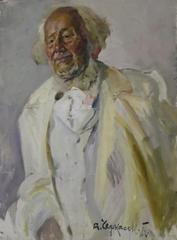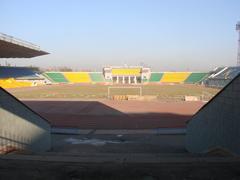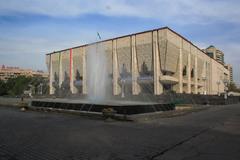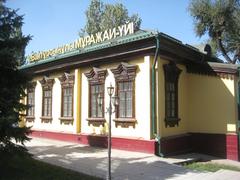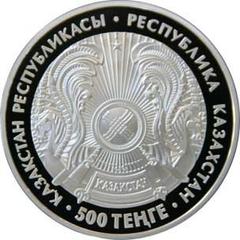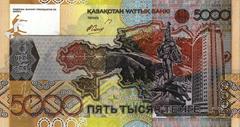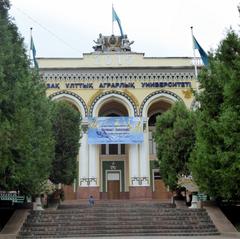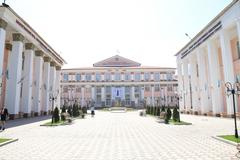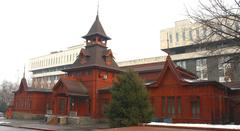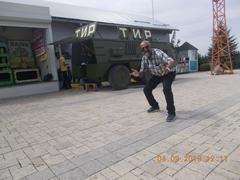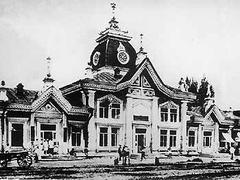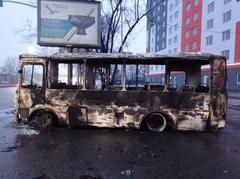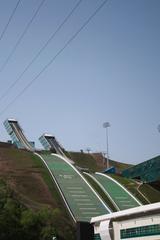
Vernenskoye City School: Visiting Hours, Tickets, and Historical Significance in Almaty, Kazakhstan
Date: 04/07/2025
Introduction
Vernenskoye City School, located in the heart of Almaty, Kazakhstan, is an enduring symbol of the city’s rich multicultural and educational heritage. Built in the late 19th century during the era when Almaty was known as Verny, the school represents a pivotal chapter in the region’s educational evolution. Today, it stands both as a functioning educational institution and a preserved architectural monument, integrated into the Almaty Museum complex. This guide provides an in-depth look at the school’s history, architectural features, cultural significance, and up-to-date visitor information, including opening hours, ticketing, accessibility, and nearby attractions.
For authoritative details and the latest updates, consult the Almaty Museum and Visit Almaty official resources (Wikipedia: Almaty, Welcome.kz).
Table of Contents
- Early Foundations and Historical Context
- Establishment and Growth of Vernenskoye City School
- Educational Reforms and the School’s Role
- Impact of Natural Disasters and Urban Development
- Soviet Era Transformations
- Legacy and Cultural Significance
- Visiting Vernenskoye City School and Almaty Museum
- Architectural Features and Styles
- Visitor Experience and Practical Tips
- Frequently Asked Questions (FAQ)
- Summary and Travel Tips
- References
Early Foundations and Historical Context
Almaty, formerly Verny, was established as a Russian military outpost in 1854 and quickly grew into a vibrant urban center (Wikipedia: Almaty). The influx of Russian settlers, Kazakhs, and other ethnic groups spurred the creation of educational institutions. Russian imperial policies promoted Russification but also met with efforts by Kazakh reformers like Ibrai Altynsarin, who championed secular and culturally inclusive schooling (Welcome.kz: History of Kazakhstan, e-history.kz: The first schools in Kazakhstan).
Establishment and Growth of Vernenskoye City School
By the late 19th century, Vernenskoye City School had become a cornerstone of Almaty’s educational landscape, serving Russian and Kazakh children. The city’s rapid growth—reaching a population of 27,000 by 1906—intensified the demand for formal education (Wikipedia: Almaty). The school occupied an architecturally significant building, influenced by Russian Revival style, and was part of a broader network of primary schools and gymnasiums. The nearby city orphanage, now the Almaty Museum, is another notable example of this period’s architecture (Wikipedia: Almaty Museum).
Educational Reforms and Vernenskoye City School’s Role
The late 19th and early 20th centuries brought significant educational reforms to Kazakhstan. Reformers advocated for integrating Kazakh language and culture into secular curricula. Vernenskoye City School embodied these ideals, offering education to both boys and girls and blending Russian and Kazakh subjects—a progressive approach for its time (e-history.kz: The first schools in Kazakhstan).
Impact of Natural Disasters and Urban Development
Almaty suffered catastrophic earthquakes in 1887 and 1911, which devastated much of the city’s infrastructure, including schools (Wikipedia: Almaty). The destruction prompted a wave of reconstruction, with new architectural techniques emphasizing earthquake resistance. During this period, the city’s architectural landscape was enriched with buildings like the House of the Regiment of Military Assembly and the Ascension Cathedral, while Vernenskoye City School was likely renovated or rebuilt to meet new standards.
Soviet Era Transformations
With the 1918 Russian Revolution, Verny was renamed Alma-Ata and later became part of the Soviet Union (Wikipedia: Almaty). The Soviet era emphasized universal literacy and technical education, and Vernenskoye City School adapted its curricula accordingly. Many historic buildings were repurposed for state use, including the former orphanage that now houses the Almaty Museum (Wikipedia: Almaty Museum). In recent decades, preservation efforts have recognized these sites as monuments of local importance.
Legacy and Cultural Significance
Today, Vernenskoye City School represents Almaty’s diverse cultural heritage and educational evolution from imperial to Soviet and independent Kazakhstan eras. The Almaty Museum, located in the former orphanage, houses exhibits about the school and the city’s educational history, with over 40,000 artifacts spanning 11 historical eras (Wikipedia: Almaty Museum). The school itself is protected as a historical monument, ensuring its legacy endures for future generations.
Visiting Vernenskoye City School and Almaty Museum
Location and Accessibility
The Almaty Museum, within the former Vernenskoye City School building, is centrally located in Almaty at 43°14′55″N 76°56′10″E. Easily accessible by public transport, taxi, or on foot, it is near other key landmarks such as Ascension Cathedral and Panfilov Park.
Visiting Hours
- Monday to Friday: 10:00 AM – 6:00 PM
- Saturday and Sunday: 11:00 AM – 5:00 PM
- Closed on public holidays
Always confirm current hours on the official museum website before visiting.
Tickets and Admission
- Adults: 500 KZT
- Students/Seniors: 250 KZT
- Children under 7: Free
- Group tours and special exhibitions may require advance booking.
Tickets are available at the museum entrance or online.
Guided Tours and Special Events
The museum offers guided tours focusing on Vernenskoye City School’s history, educational reforms, and Almaty’s cultural heritage. Thematic exhibitions and multimedia displays, including holograms and historical videos, enrich the visitor experience.
Accessibility
The museum is equipped with ramps, elevators, accessible restrooms, and offers tailored tours for visitors with disabilities.
Nearby Attractions
- Ascension Cathedral
- Panfilov Park
- Central State Museum of Kazakhstan
- Republic Square
Expand your experience by exploring these prominent Almaty sites (Visit Almaty).
Architectural Features and Styles
Neo-Russian and Vernacular Influences
The school’s architecture exemplifies the neo-Russian style, with intricate wooden cornices, carved columns, and stucco facades. Earthquake-resistant construction techniques were incorporated after the devastating quakes of the late 19th and early 20th centuries.
Soviet Modernism
The Soviet period introduced functionalist elements—geometric forms, minimal decoration, and practical layouts—while preserving the surrounding green courtyards that reflect Almaty’s “Garden City” legacy.
Visitor Experience and Practical Tips
- Best Time to Visit: Spring (April–June) and autumn (October–November) offer mild weather and fewer crowds (oneintheorangejacket.com).
- Dress Code: Modest attire is expected. Business casual is recommended for formal events.
- Language: Kazakh and Russian are spoken; arrange for an English-speaking guide in advance if needed.
- Photography: Permitted outdoors and in exhibit areas; ask for permission before photographing classrooms or staff.
- Transport: The school is centrally located; use buses, tram, metro, or taxis. Yandex Go is a convenient ride-hailing option.
- Safety: Carry identification, follow staff instructions, and be aware of emergency procedures (welcome.kz).
Frequently Asked Questions (FAQ)
Q: What are the visiting hours?
A: Monday to Friday, 10:00 AM – 6:00 PM; Saturday and Sunday, 11:00 AM – 5:00 PM. Closed on public holidays.
Q: Are tickets required?
A: Yes. Purchase at the entrance or online. Discounts are available for students and seniors.
Q: Is the site accessible?
A: Yes, with ramps, elevators, and accessible restrooms.
Q: Are guided tours available in English?
A: Yes, but advance booking is recommended.
Q: Can I take photographs inside?
A: Allowed in designated areas; seek permission for classroom or staff photos.
Q: How do I get there from the airport?
A: Taxis and Yandex Go provide easy access from Almaty International Airport (30–40 minutes, depending on traffic).
Summary and Travel Tips
Vernenskoye City School remains a vital cultural and historical landmark, encapsulating Almaty’s educational evolution and multicultural fabric. Its integration with the Almaty Museum and proximity to other major sites makes it an essential stop for history buffs, architecture enthusiasts, and cultural travelers alike. Always check official sources for the latest visiting hours, ticket information, and events.
Enhance your visit by downloading the Audiala app for interactive guides and updates. Explore nearby attractions like Ascension Cathedral and Panfilov Park to make the most of your Almaty journey.
References
- Almaty, Wikipedia
- Almaty Museum, Wikipedia
- History of Kazakhstan, Welcome.kz
- The first schools in Kazakhstan, e-history.kz
- Visit Almaty Official Tourism Site
- Everything You Need to Know Before Visiting Almaty, Inditourists.com
- Travel in Kazakhstan Guide, Journal of Nomads
- Best Time to Visit Almaty, One in the Orange Jacket

